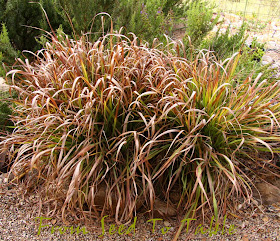Lemongrass is easy to grow in my zone 9b garden. I used to grow it in a pot near the house for fear of losing it to frost or a freezing night. The warmth of a southern facing wall and/or an overhang can provide a few degrees of protection on the coldest nights and I've kept quite a few tender plants alive through the winter with that minimal protection. But a few years ago I took a chance on growing it out in the garden, albeit under the protection of the edge of an overhanging oak tree. The plants there have done quite well in spite of enduring a few freezing nights every winter, down to about 23ºF last December. They do tend to look rather raggedy by the end of the winter though. Here's my two plants this morning. They may look brown and on the verge of expiring but...
there's plenty of life remaining in there.
All I need to do now is to put on a pair of gloves and start pulling out the dead blades. Gloves are a necessity for this task because these leaf blades are indeed sharp. But the task is easy, although tedious. Most of the blades can be simply pulled out. Grooming the plants is not just a matter of aesthetics though, if the dead blades are not pulled out they rot and the rot can infect the entire plant and kill it. The dead leaf blades are quite tough though and in spite of tending to rot at the base they don't seem to like to rot in the compost unless you chop them up. I generally send them through my chipper/shredder before putting them in the compost.
The stalks aren't very big at this time of year but they are still flavorful and these two will be a nice addition to my next pot of chamomile tea. I generally just pull a couple of stalks from the periphery of the plant, I can usually just give them a twist and they pull right off. On a younger plant you may damage the plant if you harvest that way so you may need to cut the stalks off with a knife or a pair of clippers. Lemongrass is best when fresh, it seems to lose most of its flavor and aroma when dried. I haven't tried freezing it though since I've not really found it necessary to preserve it because I can always find a fresh stalk to harvest.
Look closely at the stalk on the right and you can see a bud near the base. This stalk can be rooted to grow a new plant and that bud will grow into a new stalk and so on until you have a nice clump of lemongrass. You can read about how I propagate new lemongrass plants here.
Few things seem to bother lemongrass other than the cold. This is one of the few edibles I grow that are not bothered by deer, rabbits, gophers, or other rodents. They don't seem to be bothered by insect pests in my garden although the sowbugs, earwigs, and snails like to find shelter in them. They can be too happy to be fed in mild climates and can take over a space quite quickly so I generally don't feed my plants. They can tolerate fairly dry conditions but do best with regular watering, don't overwater though, rot seems to be the major problem that I've had with them.
For gardeners in cold climates who wish to grow lemongrass you can find some excellent advice from Dave on his blog Our Happy Acres.




Nice! I wanted to grow it too, in a pot of course. Maybe I'll try next year.
ReplyDeleteThanks for sharing :)
I so wish I could grow lemongrass as a perennial in my garden but alas, that will never happen. I used to grow it as an annual from rooted lemongrass purchased from the store but the measly harvest didn't prove worth the effort.
ReplyDeleteI've yet to try lemongrass as it isn't hardy here. I keep thinking about it though.
ReplyDelete